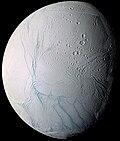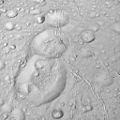Enceladus (moon)

Enceladus[1] is a moon of Saturn. It is the sixth largest of Saturn's moons,[2][3][4] and it has a diameter of 500 km.[2] Enceladus is within Saturn's E ring[2] and likely contributes material to it. The moon is made mostly out of water ice, so it reflects light very well.[5] It reflects almost 100% of the sunlight that strikes the moon, making it the most reflective moon.[6]William Herschel discovered Enceladus on August 28, 1789.[2] In 2014, NASA reported that its Cassini spacecraft found evidence for liquid water on Enceladus. Scientists now think that there is a large underground ocean of liquid water, around 10 km thick, near Enceladus' south pole. There are also cryovolcanoes (cold volcanoes) near the south pole. These volcanoes shoot large jets of water vapor, other volatiles, and some solid particles like sodium chloride crystals and ice particles into space. Some of these substances become part of Saturn's E ring.
References and notes
- ↑ Pronounced: en-SELL-ah-dus.
- ↑ 2.0 2.1 2.2 2.3 Cox, Brian; Cohen, Andrew (2010). Wonders of the Solar System. HarperCollins. p. 96-102. ISBN 9780007386901.
- ↑ Cain, Fraser (2009-12-28). "Enceladus". Universe Today. Retrieved 2011-04-04.
- ↑ How it Works Book of Space. Imagine Publishing. 2010. p. 62-63. ISBN 9781906078829.
- ↑ "NASA: Jet Propulsion Laboratory: Cassini Soltice Mission: About Saturn & Its Moons: Saturn's Moons: Enceladus". NASA.
- ↑ "NASA: Solar System Exploration: Planets: Saturn: Moons: Enceladus". NASA. Archived from the original on 2007-08-01. Retrieved 2011-02-06.
Enceladus (moon) Media
John Herschel, the astronomer who suggested that the moons of Saturn be named after the Titans and Giants
Enceladus orbiting within Saturn's E ring
An atlas of Enceladus's south pole quadrangle, which is dominated by the tiger stripes









